In Australia, the average profit margin in commercial cleaning sits between 10%–15% after wages, overheads, supplies, insurance, and tax. Larger operators with streamlined systems can push that to 20%, while smaller businesses may operate closer to the lower end.
Why the range? Because margins hinge on:
- Staff wages (the biggest cost)
- Type of clients (offices vs warehouses vs medical sites)
- Frequency and complexity of cleaning
- Overheads like insurance, super, chemicals, and admin time
In Dandenong South — a mixed industrial and commercial precinct — cleaning contracts often involve large-scale spaces with high foot traffic. That means higher volume, potentially lower margin per job, but more consistent work.
Why Do Margins Matter in Dandenong South Specifically?
Margins in this area are heavily shaped by two things:
- Local competition and pricing pressure:
With many operators servicing the Dandenong corridor, price competition is fierce. Some businesses undercut rates just to win contracts, even if it shaves their margin down to 5% or less. That’s unsustainable and often leads to staff burnout or quality drops. - Client expectations:
Many businesses in the area — especially logistics and manufacturing — expect cleaners to handle high-dust, high-traffic environments efficiently. That means higher cleaning standards, which increases time and cost per job.
A fair profit margin in Dandenong South must balance competitive pricing with sustainable operations — not just lowball to win a tender.
How Do You Calculate a Fair Margin?
Let’s say you’re quoting for a weekly cleaning contract in a 1,000 sqm office-warehouse site.
Here’s a rough breakdown:
- Wages (cleaners + super): $35/hour × 10 hours = $350/week
- Supplies and PPE: $20/week
- Insurance + admin overhead: $30/week
- Total operating cost: $400/week
- Add 15% profit margin: $460/week quote
That $60 isn’t all going in your pocket. It covers unexpected expenses, breakages, touch-ups, and downtime. Cleaning is a low-margin business — but scale, efficiency, and client trust can improve profitability.
Is It Ethical to Charge Higher Margins?
Yes — if the value matches the fee.
Many Dandenong South clients prefer providers who:
- Show up consistently
- Manage compliance (especially in food-grade or medical sites)
- Communicate clearly
- Avoid staff churn
If you’re ticking those boxes and solving real pain points for clients, then charging 20%+ margin is not only fair — it’s deserved. It reflects not just mop-and-bucket work, but peace of mind.
On the flip side, gouging clients without adding value eventually backfires. Word gets around fast in local business communities. (And no one likes finding out their “after-hours cleaner” is subcontracting to someone underpaid and poorly trained.)
What Are Signs You’re Pricing Too Low?
Here’s where reciprocity — one of Cialdini’s persuasion principles — comes in. If your team is giving more than they’re getting, something’s off.
Watch out for:
- Frequent overtime with no profit bump
- Clients asking for “just one more thing” each week
- Staff cutting corners to keep up
- You dreading invoice time because you know it barely covers costs
If you’re regularly walking away from a job feeling like you’ve done more than you’ve earned, your margins need adjusting.
What About Industry Benchmarks?
According to the Australian Cleaning Contractors’ Alliance, professional commercial cleaners should charge between $35 to $60 per hour depending on the job type and complexity. That figure includes a fair profit margin — generally 15% to 20%.
But keep in mind, the “rate” is not your “take-home.” It’s what’s left after you pay fair wages, gear, overheads, and admin time.
So if you’re quoting $30/hour just to undercut competition, you might actually be paying out of pocket to do the work.
What Can Improve Margins Without Raising Prices?
Rather than lifting your rates, you can increase your margin by:
- Training staff for faster, more efficient workflows
- Using concentrated, cost-effective chemicals
- Batching jobs geographically to cut down travel time
- Switching to smarter scheduling tools
- Negotiating better supply rates from wholesalers
Anyone who’s cleaned large-scale facilities knows — a few minutes saved per shift adds up fast.
Are Clients Willing to Pay More for Better Service?
Absolutely — especially in industrial zones like Dandenong South where compliance, reliability, and consistency are critical. Clients burned by fly-by-night operators often come back saying:
“We just want someone who shows up, does the job properly, and doesn’t disappear.”
This is where the principle of authority comes into play. If you can demonstrate experience, case studies, or client references, you can justify a margin above 20%. Your service isn’t a commodity — it’s a solution to a recurring headache.
FAQ
What’s the minimum profit margin I should aim for?
Aim for at least 10% to remain sustainable. Anything lower puts you at risk of operating at a loss once unexpected costs hit.
Can higher margins hurt my chances of winning contracts?
Sometimes — but not always. Clients looking for value and reliability will often choose quality over price, especially after a poor experience with a cheaper provider.
Should I price differently for Dandenong South vs CBD?
Yes. Dandenong South clients may expect lower hourly rates than inner-city businesses — but adjust your quote based on site size, frequency, and complexity.
Understanding what’s “fair” in commercial cleaning isn’t just about comparing invoices — it’s about building a business that works for you and your team long-term. If you’re unsure whether your rates are in line with the area, this breakdown of commercial cleaning Dandenong South offers useful context.

